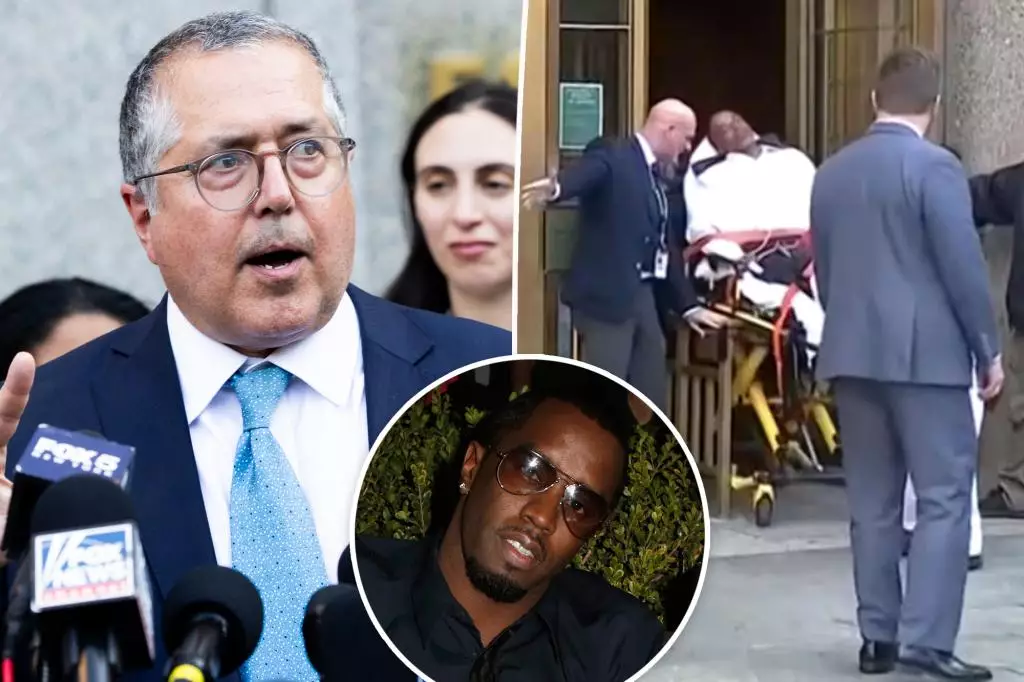Courthouses are typically bastions of order, where the gravitas of justice is met with dignity and discipline. Yet, on a day when Sean “Diddy” Combs’ legal fate was being decided, an unexpected emergency shattered this veneer of control. The incident involving a civilian collapsing in the midst of a high-profile trial reveals both the unpredictability of human health crises and the intense emotional pressure that often accompanies legal proceedings involving celebrities. Strikingly, in the chaos of a moment meant for judicial deliberation, medical emergencies surfaced prominently, forcing those present—even the seasoned legal practitioners—to confront life’s fragility head-on.
This incident wasn’t just a minor distraction; it starkly underscored the blurred boundaries between normalcy and chaos. The collapse, with blood and vomit pouring from the individual’s mouth, painted a vivid picture of a person in grave distress. What makes this event even more compelling is how quickly the situation was met with decisive action. Lawyer Marc Agnifilo, who was closest, prioritized life-saving measures over legal protocol, illustrating that beneath the veneer of courtroom professionalism lies an innate human instinct to help, regardless of the setting. The immediate response—placing the person in the recovery position, guiding their head, and coordinating with others—demonstrates the importance of being prepared for unpredictability, a lesson many legal professionals and public figures should take to heart.
Legal Proceedings Amidst Unforeseen Chaos
While courtroom dramas often revolve around legal strategies, evidence, and verdicts, few moments shift attention as rapidly as a medical emergency. Sean Combs, the iconic musician and entrepreneur, was in the midst of a pivotal day when news of his trial verdict was looming large. The atmosphere had tension, excitement, and perhaps some anxiety; everyone was eager to see if justice would favor the rapper-turned-business mogul. Yet, within minutes, all focus shifted to the individual convulsing outside court.
This event also cast a spotlight on the privileges—and the vulnerabilities—of high-profile cases. Combs, although guilty of transportation to engage in prostitution, escaped more severe charges of sex trafficking and racketeering, which could have extended his prison time significantly. His sentence scheduled for October 3 promises a tense conclusion to this legal saga. Nonetheless, the spectacle outside the courthouse reminded everyone that behind the courtroom facade are real people with real health issues, regardless of reputation or legal status.
The incident’s timing added a layer of complexity; cameras were already rolling, awaiting to capture Combs’ post-verdict sentiments. Instead, they documented a scene of medical professionals rolling out someone on a stretcher, punctuating how swiftly a moment can shift from legal triumph to human vulnerability. The unpredictability of such events serves as a stark reminder that no matter the stakes in the courtroom, the human element will often override the scripts and legal scripts.
The Fine Line Between Public Success and Humanity
Celebrities like Sean Combs often seem insulated from ordinary life, shielded by fame, wealth, and a constant media presence. However, this incident reveals the profound reality that no amount of success or fame can immune individuals from life’s unpredictability. It emphasizes that even in moments of triumph or relief, human life remains fragile. The emergency showcased that behind the headlines and courtroom disputes lies a collective of people with shared vulnerabilities.
Additionally, the quick and competent response from legal team members exemplifies a broader lesson on preparedness and compassion within tense environments. These professionals, often viewed through a lens of professionalism and detachment, proved that instinct and empathy are natural responses when faced with human suffering. Their actions also serve as a reminder that the true measure of character is how individuals respond under unforeseen circumstances—something that transcends legal or celebrity status.
This chaotic moment also made one question the broader societal attitude toward health crises: Are we truly equipped to handle emergencies in all settings, especially those involving high-stakes public figures? The incident underscores the importance of integrating emergency response training into all professional environments, including courts, where sudden crises can occur. It challenges the collective to recognize that the veneer of control is often just that—a veneer—and life’s unpredictability can strike at any moment, regardless of the circumstances.
In essence, the courthouse episode transcended a mere footnote in a legal case; it became a vivid reminder that beneath the surface of fame, fortune, or legal victory, we are all fundamentally human, susceptible to the vulnerabilities that make life precious and unpredictable.

